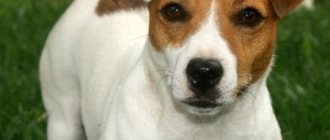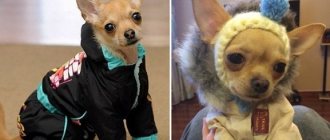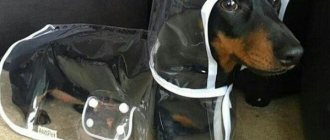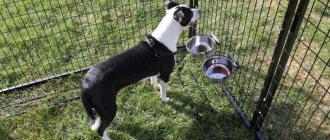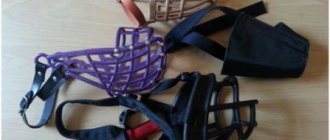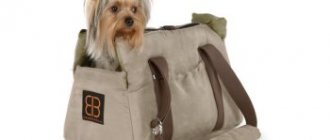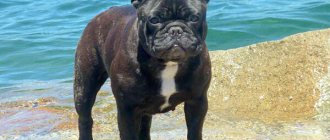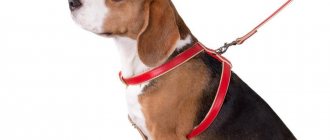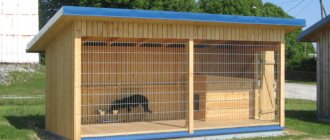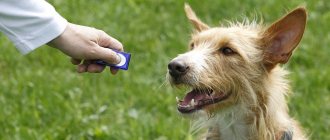Why do you need a headdress?
To protect the dog from the cold in winter, dog owners most often simply shorten the walking time, but this is not the best solution for the pet - he will not be able to waste all his energy and will remain dissatisfied.
It is better to dress your dog warmly, and most importantly, protect your head from hypothermia with a hat. Not all dogs need such an update and not under all circumstances, but many owners like to dress up their pets, making them more “fashionable.” However, with the onset of cold weather, certain breeds simply need a hat. By helping the ears and head not to freeze, it not only provides the animal with comfort, but also prevents the occurrence of such serious problems as meningitis or chronic otitis media.
Purpose, functional features of hats
There are breeds and categories of dogs for which a hat is a solution in a certain situation.
First of all, these are animals with ears hanging almost to the ground - cocker spaniels, dachshunds, basset hounds and others. While walking, their ears often touch the ground, grass, etc. As a result, such a dog comes home with, at best, just dirty ears, and at worst, with some thorns attached.
This can lead to ticks on your ears, which often happens. Washing not only the paws, but also the ears after each walk, cleaning and combing them is an activity that brings no pleasure to either the dog or the owner.
Therefore, a special cap was developed for them, similar to a children's cap, only with hollow ears. These are pockets for the ears, shaped like mittens.
What breeds require
First of all, miniature dogs, especially short-haired ones such as Chihuahuas, dachshunds and pugs, need a headdress. They do not have natural protection from the cold, and high activity leads to rapid consumption of energy reserves.
Did you know? In Ancient China, the emperor's guard included... Pekingese. These little dogs were hidden in the sleeve; in case of danger, they unexpectedly jumped out, rushing at the enemy.
The list of animals that require full equipment includes hairless breeds, as well as those from tropical regions (for example, native to Africa), which by nature cannot stand the cold. Usually they are not walked in winter, but if there is still a need to go for a walk, a jacket and hat are necessary to maintain the pet’s health.
For breeds with cropped ears, a hat is necessary because it helps prevent otitis media. In humid, snowy, frosty weather, it will protect your ears from cold and moisture getting into them.
Dog breeds that require clothing include the Pomeranian, Russian Toy Terrier, Toy Fox Terrier, Biewer Yorkie, Pharaoh Hound, and Miniature Pinscher.
Dogs with large ears require a hat in extreme cold, because due to the size of the ear, the wind can blow through the head too much, which can lead to otitis media.
Other breeds can do without hats, but there are certain reasons that make a hat necessary:
- chronic otitis;
- weak immunity (postoperative rehabilitation or a previous serious illness can temporarily reduce the body’s protective functions).
Model selection
It is often recommended to knit hats with holes for ears. Especially when the pet has erect ears. But, if you knit the hat not too tight, it will not press or press the ears too hard. In addition, during a walk, the ears will be protected from wind and cold, and the dog will not experience any discomfort. This is especially true for dogs with sensitive ears that are prone to ear infections.
This model of dog hat is good because it will not fly off the head. In addition, a restless four-legged animal will need to try very hard to pull the hat off its head.
To cover or not to cover your ears
Some experts recommend always knitting hats with slits for ears. Dogs, as you know, are proud and value their hearing, so their owners must protect it. A dog's hat should not press or put too much pressure on the ears. It's better to make small slits. If the hat is too tight and dense, then the dog simply will not hear the owner, his hearing will become dull, and he may get lost.
There are other cases. For example, when your dog has very sensitive ears that tend to catch colds. In this case, as you understand, it is better to choose a hat model with closed ears. They will be protected from the wind, and the animal will not experience any discomfort after the walk.
Types of hats and how many you need
Accessories for dogs can be of different types and styles. For frosty weather, you will need a winter hat that will protect your pet’s ears and head from the wind and cold. It is desirable that the material of the headdress has a waterproof surface.
Hooded hat
Here are some more popular types of hats:
- Hooded hat. Universal model – suitable for dogs of any size (including large breeds) with small ears. The product resembles a helmet in appearance. The headdress is fixed on the dog using ties or a closed loop. The hat is suitable for wearing at any time of the year, except summer.
- Closed accessory. It is made of dense fabric folded in several layers, thanks to which it perfectly protects from wind and cold. Most models are designed for breeds with small or cropped ears. When wearing such a product, pets with long ears will experience discomfort.
- Bonnet, or low-slung hat. This is a headdress consisting of two parts - a hood and a muff. The product is suitable for dogs with long hair. Recommended to be worn with overalls. The hat is made of elastic material. The headdress is somewhat narrowed at the top and widens at the bottom, making it easy to take off and put on.
- Scarf muff. The accessory is designed for pets with long drooping ears. An elastic band is sewn into the upper and lower parts of the product. The top drawstring allows you to wear the headdress in different ways - either put it on completely, or cover only your ears. Scarf-muffs often come with overalls - the product is secured using buttons, zippers or loops.
- Caps, or a hat with a visor , are a summer accessory that protects your pet from overheating. Also used as a decorative headdress. There are two types of caps – those with ear holes and those with a solid top. The presence of a visor for sun protection is not at all necessary - a nice detail only complements the image. The exception is the case when the dog suffers from photophobia - then the visor will be very useful.
- Hat with slits for ears. Ideal for pets with erect ears. Intended for everyday wear in the off-season.
- Decorative hat. This includes any of the above-mentioned headdresses, created without specific purposes. They are used as decoration and nothing more. Helps emphasize the individuality of the owner and his four-legged friend.
This is what a warm hat with a pompom looks like for a dachshund
Hat with pompom for dachshund
In addition to the species division, hats are classified depending on the size of the animal. Models of hats for small dogs are distinguished by a wide variety of decorative products that do not serve a functional purpose, while products for large breeds always imply a certain practical benefit. These hats are made of dense, windproof fabric and are always equipped with fasteners. On large short-haired dogs, classic hats with ear flaps designed for people look great (given their small size - for children and teenagers).
We will need
Selecting threads for knitting is a very important point. I do not recommend using 100% wool yarn, as it can be too scratchy. This is especially important for sensitive dogs and pets prone to allergic reactions.
I took Kamtex “Budget” yarn, the composition of which is 40% wool and 60% acrylic. It is better to take yarn in two different colors. After all, we are knitting a deer hat for a dog, and it will look better if the horns are a different color and do not merge with the hat.
It took me about 2/3 of a skein for the main fabric of the hat. But just a little for the horns. But it's very good. After all, from the remaining threads you can easily knit another deer hat and give it for the New Year to your best four-legged friend with whom you spend time on walks.
We will knit the hat itself, and crochet the ears and horns. Therefore, we will need knitting needles and a hook. It is better to take thicker knitting needles. This way the knitting will be more textured and expressive.
I knitted the deer hat with two knitting needles, and then sewed the edges together. This is an easier option for beginners. But the hat can also be knitted with a single piece of fabric. This option is suitable for those who know how to use or who have circular knitting needles.
Taking measurements
The first thing we do is take measurements. There shouldn't be any problems here. After all, this is not a jumpsuit or a sweater, with which everything is much more complicated. The most important measurement that we will need for our model is head circumference. I also measured the neck circumference. But this could not have been done.
Yarn selection
A very important point is the choice of threads for knitting. Knitted hats for dogs should be warm and at the same time comfortable to wear. Do not buy 100% wool threads that are too scratchy for hats. It is better to give preference to children's acrylic or natural cotton.
As you know, many small breeds often suffer from various allergic ailments. They can also be used for knitting yarn. How to check the yarn? Take a small piece of thread, apply it to the inside of your elbow and rub for a while. If your skin does not react to the friction of the thread, you can buy it to knit a pet’s hat. If spots appear on the skin, redness appears, and unpleasant itching begins, then it is better not to use such a thread.
the most fashionable and comfortable styles and models (+ photos and videos)
Are hats necessary for dogs or is this just another trick of the “manufacturers” of dog glamor? They are necessary, but only for some dogs and under certain circumstances. If you like to dress your pet, then a hat or a fashionable cap will add a “zest” to the image of your four-legged dog.
Why and what dogs need hats
The most obvious purpose of a hat is to insulate the head and ears. Usually, in winter, owners reduce walking time, the dog remains dissatisfied with the lack of activity and takes out its dissatisfaction at home. Low physical activity is contraindicated for puppies, but hypothermia is also dangerous for them. This is where clothes, hats and shoes come to the rescue.
Representatives of miniature breeds also need winter hats for dogs. Small four-legged animals are very close to the ground, which means they freeze more. No matter how fast the toy’s metabolic processes are, he is not able to warm himself in 25° below zero. A similar situation arises with Pugs and almost all short-haired, stunted dogs.
Hairless and African breeds of dogs are not a priori adapted to cold weather, and frosty weather is dangerous for their lives. Usually, overly susceptible four-legged animals are litter trained and not taken out in the winter, but again, warm clothes, shoes and a hat will free your pet from confinement.
The next candidates are breeds with short cropped ears. Frost, wind, rain and other delights of nature can easily bring your pet to otitis media. If you buy (sew) and put on a hat for your dog correctly, weather conditions will not spoil or shorten your walks.
There are a number of breeds that are prone to chronic otitis, that is, the dog gets sick as soon as it gets cold or catches a cold. Four-legged animals with sore ears are “shown” to wear a hat or scarf-muff from autumn to spring. Naturally, warm accessories do not provide any guarantees and the health of the ward must be strictly monitored.
Many veterinarians strongly recommend wearing hats for dogs with weak immune systems. For example, four-legged animals who have survived a serious illness or surgery. Most ear diseases occur due to hypothermia. In animals with weakened immunity, purulent otitis media quickly develops, and this is a very serious threat not only to the health, but also to the life of a fragile pet.
Tailed swimmers and divers also draw attention to the health of their ears. Special rubber caps minimize the risk of water getting into the ear canals. For bathing in the bathroom, there are cellophane caps. By the way, regular shower caps will also work.
Note! Four-legged animals with black or dark colors are at risk of overheating. A white hat with a visor will protect your pet's head from direct sunlight. Naturally, the material of the accessory should be light and breathable (linen, cotton).
Types of dog hats
Before you go to the pet store or unpack your sewing supplies, you need to decide on the type and style of the accessory you need. In the case of a winter hat, the requirements are very clear:
- Protection from cold.
- Wind protection.
- Preferably a waterproof surface.
When purchasing (or choosing materials), pay attention to the inner layer, that is, the lining. No synthetics, stretch or “glass” fabrics. A baize, terry cloth or knitted fabric is acceptable. You should refrain from purchasing wool and down products. The former (oddly enough) can cause irritation and allergies, the latter can be made from cheap raw materials. The surface of the cap (outer layer) should be as dense as possible, but still breathable. Oilcloth materials are unacceptable, since the greenhouse effect will have a detrimental effect on ear health. The first threat is the same otitis media. The second is the rapid proliferation of pathogenic bacteria. Our pets' ears are not sterile (this is no secret), but in normal temperatures and humidity, unfriendly microorganisms behave calmly. Increased humidity and heat create more acceptable conditions for microbes to “wake”, and therefore for the development of an infectious focus.
The hooded hat is the most common model, suitable for four-legged animals of any size with small ears and for large breed dogs. The product looks like a helmet and can be equipped with ties or a closed loop that secures the hat. Accessories are used for walks in spring, autumn and winter.
Closed hat - made of several layers of dense material, protects the dog from frost and wind. The majority of models are designed for dogs with small and cropped ears. For dogs with large ears, hats are made by hand or to order. Note that the four-legged dog will be quite uncomfortable when wearing the accessory, but in the case of chronic otitis media or a severe cold, there are no other options.
A low-slung hat (kapor) is a cap-hood and a muff that falls down the neck. The accessory is convenient for dogs with long hair and is easy to put on and take off. Usually worn with overalls. Typically, such accessories are made of elastic thread, narrow at the top and widen at the bottom.
A muff scarf is ideal for dogs with drooping ears (spaniels, basset hounds). An elastic band is sewn into the upper part of the muff, allowing you to wear the scarf completely or cover only your ears. The bottom edge is also elasticated. Some overalls include a muff scarf that is secured with a zipper, snaps, or loops.
Hat with a visor (cap) - used for protection from the sun or as a decorative accessory. There are models with a closed top and with slits for the ears. There is no particular need for a visor; it plays a decorative role. However, for older pets, a visor may be useful, since some four-legged animals suffer from photophobia.
A hat with ear slits is a semi-decorative option because it does not protect the ears. Used for everyday wear in autumn and spring, including in damp weather. This option can be used for dogs with erect ears in winter, but it will not provide much protection from the wind.
Decorative hat - any of the above styles, made without specific purposes (insulation, ear protection). It is considered as a decorative, optional accessory to emphasize the individuality of the owner and pet.
In addition to species division, gradation according to the dimensions of the quadruped is also expected. Traditionally, hats for small dogs include a large segment of decorative products. Berets, caps without ties, caps with rhinestones and similar accessories do not serve a functional purpose. Hats for large dogs are made of durable, windproof materials and are necessarily “equipped” with fasteners and a length adjuster (fasteners). For large short-haired dogs, human hats with earflaps (child or teenage size) are suitable.
Making a hat with your own hands
Many owners are concerned about the issue of exclusivity and convenience of accessories. If you are one of the fashionistas who prefer maximum comfort, rest assured that the best hat for a dog is a hat made by yourself. No factory pattern will take into account all the nuances and preferences of your pet. In addition, large enterprises tend to save on materials, which means that a fashion accessory will contain a considerable amount of synthetics. The next nuance that you will protect yourself from is dyes that can cause allergies.
The first and easiest option is to remake children's hats, and for small dogs, accessories are made from children's tights and socks. You can get good quality baby hats for literally pennies at second-hand stores. With a little magic, hemming and adjusting the accessory to your pet, you can avoid the process of cutting and modeling. This option is suitable for needleworkers who do not have a sewing machine (or those who do not know how to use one). If you decide to remake children's things in order to save time, leave this idea; making an accessory “from scratch”, in practice, happens faster.
Now let's look at a simple step-by-step example for those who decide to knit a hat for a dog:
- Measure the circumference of your pet's head and divide this length by 2 - we get the X value (depending on the size of the dog). Next, for the length X you need to calculate the length of the loop.
- Depending on the length obtained, we collect loops and tie them up. If the dog is small, approximately 3.5–4 cm from the corner of the eyes to the ears.
- We close and tie the loops of both ear holes.
- Next, we knit a strip that will go between the ears.
- Add loops on both sides and repeat the previous step.
- Close all the loops and sew the hat.
- As decoration we add a bubo, beads, embroidery, stickers, etc.
- If necessary, sew on strings to secure the hat on the head.
Important! Try to try on the hat as often as possible during the manufacturing process. All patterns/patterns are standard and do not take into account the thickness of the fabric/threads/diameter of the knitting needles, etc.
The following dog hat pattern is suitable for knitting or sewing - a cap with open ears and a visor. The size is adjusted according to the dog.
If you crochet rather than knit, watch the detailed master class below:
An excellent option that requires a minimum of time and effort is a low-slung hat:
If you have a sewing machine, you can make a dog hat out of fleece or other warm material. Detailed master class in the video below:
Another option for craftsmen is to make a closed (or with slits for the ears) hat with ties:
An excellent option for owners of toys or other dog breeds with erect ears. Master class on sewing a closed bonnet:
Especially for fashionistas - video instructions for making a cap with an elastic band for summer walks:
Naturally, to make an accessory you will need sewing or knitting skills. By the way, knitted hats for dogs are becoming increasingly popular. Many skilled craftsmen have turned their hobby into a business! For craftsmen who own knitting needles, there are no barriers to modeling hats!
vashipitomcy.ru
Knitting a hood for a dog - knitting pattern
In order to knit a hat for a medium or small dog you will need:
- 50 grams of yarn (you can take three colors): 30 grams of the main color and 10 grams of two contrasting colors;
- knitting needles No. 2 and No. 5;
- a needle with a wide eye so that you can insert a thread of yarn;
- crochet hook.
Pay attention to the choice of yarn.
It is better to use natural, breathable materials. Wool yarn provides excellent warmth, keeps the dog warm, and prevents the dog's head from sweating.
It is also advisable to choose soft yarn so that the hat does not prick or irritate the dog. To do this, it is possible to add artificial fiber such as acrylic to the threads.
If your dog is allergic, wool fibers may not be suitable for it. In this case, you can take cotton and viscose with the addition of synthetic fiber.
The presented model is knitted with a 2x2 elastic band. Knitting density 30 loops = 10 centimeters.
To calculate the required number of loops, you need to measure the dog's head and calculate from the knitting density.
Knitting pattern
For example, the girth of a dog's head is 27 centimeters. Therefore, we get 81 loops and add 1 more loop for symmetry of the 2x2 elastic. This makes a total of 82 loops.
The second measurement is the distance between the ears. For example, 7 centimeters. It turns out 21 loops - 1 for the symmetry of the 2x2 elastic band (so that it doesn’t turn out too wide and does not put pressure on the ears). Total 20 loops.
The third measurement is the distance from the edge of the fabric (the seam of the hat) to the hole for the ears; we double the resulting size. For example, we got only 4 centimeters. This means you need to cast on 12 loops.
The fourth measurement is the length of the ear hole. We measure the width of the ears. For example, it turned out to be 6 cm. We count. Total length 27 centimeters – 7 centimeters (distance between ears) – 4 centimeters x 2 (back of hat) = 81 loops – 20 loops – 12x2 = 17 loops + 2 extra = 19 loops.
Knitting pattern
The fifth measurement is to multiply the distance from the bottom of the headdress to the ear by 2 to get a turn-up, as in the picture. For example, 3.5 centimeters x 2 = 7 centimeters.
82 loops are cast on with yarn of the main color and 8 centimeters are knitted with a 2*2 elastic band. Changing the colors of the yarn in three rows, we make stripes. The first half of the fabric can be knitted with needles No. 5, the second half with No. 2 needles.
Next we knit according to the following pattern:
- 1st row – 12 loops with 2x2 elastic, bind off 19 loops, 20 loops with 2x2 elastic, bind off 19 loops, 12 loops with 2x2 elastic;
- 2nd row – 12 loops with 2x2 rib, 15 chain loops, 20 loops with 2x2 rib;
- then knit 6 rows with a 2x2 rib;
- then gradually in each row the number of loops is reduced to the required height;
- then the cap is sewn together with a needle;
- Next, you need to crochet two chains (cap ties) with air loops and sew them to the hat in a place convenient for tying;
- At the end a pompom is sewn on.
DIY sewing
Any owner can buy a hat at a pet store, but such an accessory is quite expensive, and problems with fitting it on the head may also arise. Moreover, it will not be individual. But if you make a headdress for your beloved dog with your own hands, it will be:
- Nice;
- economically;
- comfortable - such a product will ideally fit the dog’s head, making the hat as comfortable as possible for the animal.
It can be made either from threads (knitting) or by altering children's clothing to look like a dog (altering children's berets, etc.).
Taking measurements
Before sewing any clothes, including hats, you must take measurements of the animal, because the comfort of the outfit will depend on this.
To make a headdress, the following measurements are required:
- The distance between the ears (the distance from the inner base of the left ear to the right is measured in centimeters).
- Horizontal head circumference (measured in a centimeter in a circle from the outer bases of the ears).
- Vertical head circumference (measured in centimeters from the chin around the head in a circle).
For greater accuracy, you need to make a repeated, control measurement.
Material selection
Depending on the purpose of the headdress, you should choose the right material for manufacturing. Of course, it is desirable that the fabric be natural, or at least hypoallergenic.
- For rainy, snowy days, hats made of materials that do not absorb moisture (synthetics or specially woven cotton, satin) are best suited.
- In warm hats (winter version) it is best to use wool; You can also decorate your headdress with artificial or natural fur or bubo.
- Lightweight dresses for autumn and spring are best made from knitwear.
Knitting with knitting needles
Knitting a hat from scratch is more difficult than remaking a ready-made one for children, but in this case you will get exactly what you want. A wide scope for creativity opens up before you.
- We arm ourselves with a centimeter, calm our pet and take the main measurement. We are interested in head circumference. We divide the resulting indicator in half. This is the original size.
- Now we calculate the number of loops. To do this, you need to cast on a small number of stitches (for example, 20) and knit at least ten rows with a working pattern.
- We remove all the loops from the knitting needle and measure the width of the product. Now we make up the proportion (if, for example, the width of the test product is 5 cm, and our original size is 10 cm, we will need to cast on 38 loops, since the two edge loops are not involved in determining the size).
- Now we cast on the required number of loops (we use the same knitting needles, the same thread and the same “hand”, since each craftsman has his own knitting density) and begin to knit the fabric.
- After about 3-4 cm (based on a small dog), we begin to make holes for the ears. To do this, divide the number of loops on the knitting needle into three parts (if the whole number does not work out, the central part may be several loops more). On each side of the product we close the number of loops corresponding to 1/3.
- We continue to knit only the central part of the product until it matches the size of the base of your pet’s ear.
- Now we add on each side the same number of loops that were previously closed, and finish the product symmetrically to the beginning.
- We close all the loops.
- Fold the product in half and sew a side seam to make a hat.
- Add decor (bubo, fur trim, strings, applique, etc.).
Every owner should take care of his pet and strive to ensure that his beloved dog is not only fashionable, but also healthy. Therefore, for certain breeds it is necessary to purchase hats for the winter. Well, if you have sewing skills, you can make them yourself, which will bring pleasure not only to the dog, but also to you.
Sources:
https://dekormyhome.ru/rukodelie/viazanaia-odejda-dlia-iorka-svoimi-rykami-s-vykroikami-master-klass-s-video.html https://www.syl.ru/article/292964/vyazanaya -shapka-dlya-sobaki-svoimi-rukami https://pets2.me/bok/1246-kak-sdelat-shapku-dlya-sobaki-svoimi-rukami-vidy-shapok.html
Description of crochet
You can show your imagination and knit an unusual hat.
Similarly, measurements are taken and the crochet pattern and density are calculated. In this work, it is also possible to use several colors of yarn to obtain a bright and attractive hat. The model can be crocheted using any convenient loops and knitting pattern.
Below is a description of stitch knitting. For knitting you can use hooks No. 3 and No. 4.
Crochet stitch pattern
The scheme is simple:
- cast on 6 chain stitches and knit 12 double crochets;
- Next, knit the required number of rows in a circle, doubling every sixth stitch. You need to knit in this way until you reach the place where the ear holes will be;
- according to the measurements taken, these elements (ear openings) are closed with single crochets;
- then the air loops are picked up again and the required length of the hat is knitted, also doubling every sixth loop;
- The bottom row is knitted without a double crochet and closed with a crochet step.
The product begins to be crocheted from the side of the crown, in the place where the pompom is sewn.
Then the bindings are sewn on and the headdress is decorated with a pompom.
Knitting a funnel hat for a dog
So that later we do not have to re-knit the hat several times, since we incorrectly calculated the number of loops on the knitting needles, I advise you to start with a test fragment. We cast on several loops and knit a small fragment of exactly the pattern with which we will knit the main product.
One important point! It is necessary to knit a trial version with exactly the same knitting needles and the same yarn that will be used in the future.
Our dog hat will be knitted with a 2x2 elastic band. I cast on 18 stitches and knitted a small piece with a 2x2 rib. Then I measured the length. I got exactly 10cm.
Well, then, using simple calculations, we determine how many loops need to be cast on.
Don't forget to try the hat on your pet from time to time to determine the desired length.
The length of Jack’s and my hat is about 20cm.
I think this is quite enough for a Jack Russell Terrier.
Advice! When you knit the last stitch in the main fabric of the hat, I recommend not cutting the thread too short. If you pull the thread longer, you can then use the same thread to sew the edges together.
We will crochet the horns and ears of the deer hat.
In order for the horns to be dense and hold their shape well, they must be stuffed with padding polyester.
When all the parts of the hat are connected, take your time to sew them together. Pre-mark the location of the ears and horns. I did this using regular toothpicks.
Well, then all we have to do is connect all the parts together.
OK it's all over Now. Our dog hat is completely ready.
When you walk with your pet in such a hat through the forest, be careful not to confuse your furry pet with a real deer!
Which dogs need
Hats for dogs are not only bright accessories, but in some cases a necessary element of clothing. Some breeds of pets are absolutely not suitable for walking in the cold and require significant insulation.
These include all miniature, short-haired and stunted dogs, hairless and African breeds (Yorkies, terriers, Chihuahuas and others). Small dogs are close to the ground and have a high metabolism. A dog under such circumstances generates a lot of heat in a short period of time, so it quickly freezes.
This also includes animals with short-cropped ears. This form of auricles does not cover the ear canal and does not protect the inner ear from hypothermia. This leads to otitis media and ear inflammation in cold weather. These dogs require a hat.
In the article I talked about how to knit a hat for a dog yourself. She explained how to take measurements and calculate the knitting pattern. Which yarn is best to use? She explained which dogs need a headdress.
Today, together with Jack, we will tell you how to knit a hat for a dog with your own hands. This will not be an ordinary hat, but the most winter, the most Christmas knitted reindeer hat for a dog. In addition, you can watch a video (it’s at the bottom of the page) where I show the main points of knitting such a hat.
The autumn-winter season has arrived. Severe frosts, fluffy snowdrifts and, of course, the New Year holidays are just around the corner. And in order to have time to prepare gifts for all your family and friends in advance, you need to start now.
After all, the best gift is a gift made with your own hands. And this takes time. When preparing gifts for loved ones, undoubtedly, we will not forget about our little brothers.
Some owners of four-legged animals are of the opinion that there is no need to dress dogs at all. But in an urban environment, when our pets are so accustomed to living in warm and comfortable conditions, clothing for dogs has become not only fashion, but a vital necessity. Pets no longer have such strong immunity as their distant ancestors - wolves, who were forced to spend their entire lives on the street.
In such a hat, your furry friend will not only be the most fashionable and the most beautiful. A knitted hat will protect your little dog from hypothermia and prevent him from catching a cold.
We hope that our master class: DIY knitted deer hat for a dog will be useful to you. And Santa Claus will definitely not fly past such a deer and will give him the coolest gift.
How to knit a hat for a dog
The simplest hat for a dog does not require much time or knitting experience.
Step-by-step instruction:
- Measure the circumference of the dog's head. Divide the resulting number in half. This will be the width of the product.
- Select yarn and pattern for knitting or crocheting.
- We knit the sample and calculate the loops as usual.
- Cast on the required number of loops and knit a rectangle. Its height is equal to the distance from the dog’s eyebrows to the beginning of ear growth. We received the frontal part of the cap.
- Divide the number of loops by 3 and close 1/3 of the loops along the edge on both sides, thereby forming slits for the ears. We knit the middle third with straight fabric until the ears grow. This will be the parietal part.
- For the back of the head, we evenly cast on both sides the number of loops slightly less than the original one. We knit a straight fabric to the height of the frontal part. The back of the head will be a little narrower, but this was done specifically to better fit the dog’s head.
- Now all that remains is to sew the sides of the wide parts.
- We make a fastener or make ties, sew on a pompom, and decorate with taste and imagination.
Your pet will definitely like this hat for his four-legged friend. Because most of all, dogs value the care and attention of their owner.
DIY knitted hat for a dog
As you know, most owners of small dog breeds always try to insulate their pet in the winter. Moreover, it should be noted that dressing a dog in winter is not only a kind of fashion, but also simply a harsh necessity of life. The Chinese Crested, West Highland White Terrier or Yorkshire Terrier, as well as some other breeds, do not have a furry undercoat. Consequently, when walking in winter, such animals can easily get frostbite or catch colds.
Regular hat with closed ears
So let's start our knitting. Hats for dogs, it should be noted, are knitted very quickly and simply, so even a novice knitter can cope with this task. The first option that we offer is considered classic, is very common and looks quite nice.
A similar hat for a dog consists of two elements: a front part and a back part. After knitting, simply sew the two parts together, after which the product is ready to wear.
We take measurements and divide the resulting numbers by three. Two parts will be the front part of the hat, and the third will be the back part. As with knitting most “human” hats, you need to cast on twenty test stitches on the knitting needles and knit them about ten centimeters with the knitting pattern (pattern) that you will use for the main knitting. A knitted sampler, let's call it that, will help you determine the number of loops that are needed specifically for your measurements.
We have calculated the loops, put them on knitting needles and knit a regular 1x1 or 2x2 elastic band. The height of the elastic band may vary, but, as a rule, it does not exceed three centimeters. Here, again, everything will depend on the size of the dog's head. Next you should make increases. It is better to do this through a row so that the product looks harmonious and increases gradually.
When should I finish knitting? Experts advise doing fittings after a certain number of rows. As soon as the canvas lies comfortably on your head and does not put pressure on your ears, you can finish one side and start the other.
Two parts are knitted. Let's start sewing the parts together. To prevent the hat from flying off your pet's head, you can add short strings to it. You can knit them on knitting needles or use a crochet hook (if you know how to use it). Since the corners of the hat end up sticking out, you can attach bright and cheerful pom-poms to their tops.
Types of hats
Ideally, winter head insulation should meet three types of protection:
- from cold (from late autumn to early spring);
- from the wind (at times of year when cold winds blow);
- from moisture (rainy season, snowy winters).
If a hat is able to protect the ears and head from the three “elements”, such a hat can safely be considered successful.
Hooded hat
The hooded hat is the most popular model for both small and large dogs. This headdress resembles a helmet and is held on the head by ties, buttons or rivets. It will fit all types of ears; if they are large, care must be taken that the hat does not press them too close to the head. A hooded hat is worn both in autumn and winter.
Closed hat
Closed hats are necessary for dogs with small or cropped ears. If the ears are large, and chronic otitis requires a closed head, such hats are sewn to individual order. Their peculiarity is a tight fit to the head and neck, so it will not be very comfortable for your pet to walk in such a hat, but you will have to put up with it.
Low rise hat
A low-slung hat can be called a headdress with an attached muff (“scarf without ends”). This model is suitable for all dogs and is quite easy to wear and take off. The main advantage is that not only the animal’s ears are covered, but also its neck, so that the four-legged friend is not threatened by either frost or wind.
Scarf muff
In fact, it is more of a scarf than a headdress. The peculiarity is that it can be worn either completely on the head and neck, or only on the ears (to protect against otitis media). It is ideal for dogs with cropped or small ears. This option is not suitable for breeds with large ears because the fabric fits too tightly to the head.
Hat with visor
A cap is most often used for protection from the sun or as a simple decoration. It is suitable for all dogs, you just need to take into account the size of the ears and the head itself. A cap is especially necessary for dark breeds of dogs in the summer, because they are prone to overheating. It will also help elderly dogs cope with photophobia.
Hat with ear slits
In most cases, such a headdress is decorative, because it does not cover the animal’s ears. However, many owners put such accessories on their pets, and the animals wear them with pleasure. This hat is suitable for dogs with erect ears of any size, the main thing is to fix it well on the head.
Decorative hat
Decorative hats are headwear of any of the listed models, which are used exclusively to decorate the animal and highlight its individuality against the background of other four-legged animals. Decorative clothing is chosen depending on the breed and preferences of the dog itself, as long as it does not cause him discomfort.
Hats with a neck
An elongated dog hat is considered very warm and comfortable to wear. The neckline is simply knitted with knitting needles. It not only protects from cold and wind, but also serves as a kind of fastener for the product. Such a hat will never fall off, no matter how hard the weather or your pet and his nimble, nimble paws try. It is impossible to throw off or pull such an accessory off your head.
How to knit such a hat? First, we take measurements from the head, as we did for the previous version. Secondly, we need an additional measurement here - neck circumference. Let's start again with a trial version. If this is not your first knitting project and you know the yarn, then you can immediately start casting on loops.
As usual, we knit a couple of centimeters with an elastic band. Close the loops, leaving only a small amount in the center. This center knitted piece should go straight between the dog's ears. We knit the same strip from the back side and, adding loops, we knit the part that will cover the dog’s neck. The details now just need to be sewn together.
Such a hat can also be knitted with a single fabric. But this option is for those who know how to use circular knitting needles. Do not forget to periodically try on the cap so that it is not too short or narrow. This hat can be worn both under a regular walking suit and under a winter overall. It resembles a child's bib.
Types of hats
Ideally, winter head insulation should meet three types of protection:
- from cold (from late autumn to early spring);
- from the wind (at times of year when cold winds blow);
- from moisture (rainy season, snowy winters).
If a hat is able to protect the ears and head from the three “elements”, such a hat can safely be considered successful.
Hooded hat
The hooded hat is the most popular model for both small and large dogs. This headdress resembles a helmet and is held on the head by ties, buttons or rivets. It will fit all types of ears; if they are large, care must be taken that the hat does not press them too close to the head. A hooded hat is worn both in autumn and winter.
Closed hat
Closed hats are necessary for dogs with small or cropped ears. If the ears are large, and chronic otitis requires a closed head, such hats are sewn to individual order. Their peculiarity is a tight fit to the head and neck, so it will not be very comfortable for your pet to walk in such a hat, but you will have to put up with it.
Low rise hat
A low-slung hat can be called a headdress with an attached muff (“scarf without ends”). This model is suitable for all dogs and is quite easy to wear and take off. The main advantage is that not only the animal’s ears are covered, but also its neck, so that the four-legged friend is not threatened by either frost or wind.
Scarf muff
In fact, it is more of a scarf than a headdress. The peculiarity is that it can be worn either completely on the head and neck, or only on the ears (to protect against otitis media). It is ideal for dogs with cropped or small ears. This option is not suitable for breeds with large ears because the fabric fits too tightly to the head.
Hat with visor
A cap is most often used for protection from the sun or as a simple decoration. It is suitable for all dogs, you just need to take into account the size of the ears and the head itself. A cap is especially necessary for dark breeds of dogs in the summer, because they are prone to overheating. It will also help elderly dogs cope with photophobia.
Hat with ear slits
In most cases, such a headdress is decorative, because it does not cover the animal’s ears. However, many owners put such accessories on their pets, and the animals wear them with pleasure. This hat is suitable for dogs with erect ears of any size, the main thing is to fix it well on the head.
Decorative hat
Decorative hats are headwear of any of the listed models, which are used exclusively to decorate the animal and highlight its individuality against the background of other four-legged animals. Decorative clothing is chosen depending on the breed and preferences of the dog itself, as long as it does not cause him discomfort.
Unusual option
Knitting this hat will be somewhat unusual. If in the first versions we first knitted an elastic band, then here we will do the opposite. We knit three centimeters in stockinette stitch and then move on to knitting 1x1 elastic. If you want, of course, you can replace this pattern with any other. But, speaking about beginner needlewomen, we note that this pattern is the simplest and easiest. If this is your first dog hat, then it is better to choose this one.
You need to knit up to the ears. Next, you need to make holes for each ear. To do this, simply close the required number of loops on both sides and continue knitting. Remember that as you continue knitting, you should have the same number of loops as you originally had. When you knit the first row after decreasing for the ears, you will need to pick up the stitches above the closed ones.
Next we knit up to the neck. When there are a few centimeters left before finishing, you should make a few increments. Here we recommend using regular yarn overs. They will allow you to make the product a little wider at the end of knitting and at the same time prevent holes that beginners get when adding loops in other ways.
Pompoms
The most popular decoration for hats are pom-poms. If you look at hats for dogs, photos of which are presented on various relevant resources, then in most options you will see pompoms. They make any hat, even the simplest one to knit, more attractive, mischievous and unusual. How to make them?
Take a sheet of thick cardboard. Cut out a circle of the required diameter from it. If there is a larger pom-pom, then the circle, accordingly, should be wider. We will need two of these circles. We make a hole in the middle of each of them using scissors. Connecting the circles together. We take a skein of thread and begin to weave circles until you think that the pompom will be fluffy enough.
Let's take the scissors and let's do the magic. First, cut the upper edges of the threads. Carefully push the cardboard parts apart and tighten the middle with thread. We remove the details completely, strengthen the central thread completely and fluff the pompom. If there are threads that stand out from the total mass, the length can be adjusted using scissors.
So, the dog’s hat is ready. It can be decorated with any available means: rhinestones and bows, pompoms and stickers, ribbons and hairpins. You can crochet additional bright elements and simply sew them onto the finished hat.
How to train a dog to wear a hat
If the dog is already an adult, it is unlikely that it will calmly react to the fact that a headdress is put on it. You need to do this carefully, without causing pain. The animal should not associate bad emotions with the hat. Give it some time to walk around the house in it. Take off the hat and give the dog a treat. Gradually increase the time you wear the headdress. Reward for obedience every time. The animal must understand that this accessory is necessary and very important for it.
Puppies should be trained in the same way as adult pets. But it is easier to do this at an early age. Puppies get used to any innovations faster. If all efforts to accustom your pet to a hat are unsuccessful, he feels discomfort, there is no need to do it by force. This will further strengthen the hostility towards hats and cause psychological trauma. It is better to consult a dog handler and choose an individual approach to the dog.
